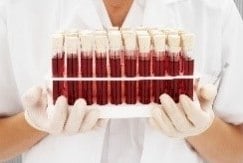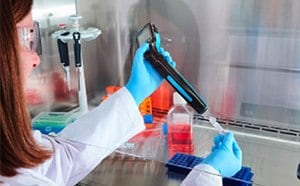Hematology

Hematology (haematology) is the clinical study of blood, blood-forming organs, and blood diseases. Human blood is composed of ∼45% cellular components and ∼55% plasma and plays an essential role in transporting oxygen, regulating body temperature, and supporting the immune system.
The three major cellular components, comprising of red blood cells (RBCs, erythrocytes), white blood cells (WBCs, leukocytes), and platelets, are essential for understanding, predicting, diagnosing, and treating a variety of hematologic diseases and disorders. They include blood infections, blood cell cancers, genetic disorders, autoimmune issues, and complications related to transfusions and pharmaceutical interactions, such as chemotherapy.
Featured Categories
We offer a complete selection of microscopy reagents, tools, and glassware for research and clinical lab analysis from Corning®, BRAND®, PELCO®, and other reliable specialty brands.
Monitor, analyze, and assay your cells with digital cell imaging and live cell imaging instruments for reproducible cell cultures and reliable, predictive results.
Accurate, consistent cell counting is critical for cell culture and downstream cellular assays and experiments. A handheld coulter counter provides the most accurate and reproducible cell counts in seconds. Disposable hemocytometers reduce risk in infectious settings.
Accurate, consistent cell counting is critical for cell culture and downstream cellular assays and experiments. A handheld coulter counter provides the most accurate and reproducible cell counts in seconds. Disposable hemocytometers reduce risk in infectious settings.
Hematology and Oncology
Hematologists have a challenging role to play in the field of oncology. Major blood cancers, like lymphoma, leukemia, and myeloma, account for approximately 10 percent of all new cancer diagnoses. These cancers affect blood cell production or alter their behavior, which can be treated with hematology validation in addition to typical therapies including radiation, chemotherapy, immunotherapy, and stem cell transplantation.
Hematology Staining and Analysis
Histological staining of blood and blood-related tissue has been the standard method of analysis in hematology since the late 19th century. Panoptic staining according to Pappenheim, and staining according to Giemsa, Wright and Leishman, have continued to be the standard techniques in hematological diagnostic procedures, with various chemical modifications made to improve staining differentiation or specificity.1 Historically, most hematological samples were analyzed manually. Today, most samples are analyzed using semi- or fully automatic staining systems capable of determining all parameters necessary for diagnosis. Pathological or suspect blood and bone marrow smears are then subjected to classical differential analysis using stains, in addition to an antibody or genetic analysis if indicated.
Visit our document search for data sheets, certificates and technical documentation.
Related Articles
- Immunohistochemistry (IHC) represents an indispensable tool in cancer diagnostics.
- Review the physical properties of blood and plasma and blood composition on the cellular level.
- Enzyme Explorer offers products and resources for red blood cell research, including hemoglobin, heme products, and erythrocytes.
- Two separate studies were conducted to analyze long-term storage of blood in DNAgard Blood stabilization reagent.
- Explore our staining kits and solutions for hematological differentiation and diagnostics. Our hematology products are all IVDs, CE certified and ready-to-use.
- See All (7)
Related Protocols
- Proper laboratory glassware cleaning techniques are crucial for high-quality results in experiments and research.
- The following procedure has been evaluated with Ficoll-Paque PLUS and is recommended for separation of normal blood samples for maximum reproducibility.
- See All (2)
Find More Articles and Protocols
How Can We Help
In case of any questions, please submit a customer support request
or talk to our customer service team:
Email custserv@sial.com
or call +1 (800) 244-1173
Additional Support
- Calculators & Apps
Web Toolbox - science research tools and resources for analytical chemistry, life science, chemical synthesis and materials science.
- Customer Support Request
Customer support including help with orders, products, accounts, and website technical issues.
- FAQ
Explore our Frequently Asked Questions for answers to commonly asked questions about our products and services.
Reference
To continue reading please sign in or create an account.
Don't Have An Account?



